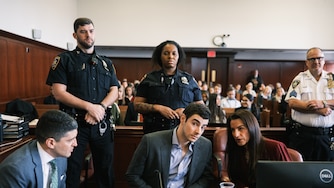Less than a week after the County Executive vetoed a bill to address overcrowding, Baltimore County Public Schools announced its sixth redistricting in the last two years.
It’s the second time this year the northwest part of the county will move elementary school kids around. The goal is to relieve crowded school buildings and to accommodate the new buildings replacing Deer Park and Scotts Branch elementary schools.
Parents have been frustrated by the frequency of redistricting in recent years. Hampton Elementary parents, for example, had complained that their school was still overcrowded a few years after attendance boundaries were redrawn.
The bill that County Executive Johnny Olszewski Jr. vetoed used suggestions from a 2020 task force that sought ways to relieve school crowding. One recommendation, which the bill adopted, was to change the county’s definition of overcrowded from 115% to 105% of a school building’s capacity. In other words, if a school were built to hold 100 kids, under the bill it would be considered overcrowded when 105 were enrolled, instead of 115.
It also would have required developers to obtain permission from a committee if they wanted to build new housing near an overcrowded school. If denied a permit from the committee, a development would be placed on a waiting list for up to four years. Once that period expires, the development would automatically receive approval regardless of school capacity, noted Julie Henn, a school board member who was part of the 2020 task force.
“The pause gives Baltimore County and BCPS time to address the gaps in school capacity,” said Henn.
Read More
But the bill is now dead unless the council votes to override Olszewski’s veto.
The county executive saw the bill doing more harm than good.
“While we applaud the intentions of the members of the County Council seeking to address school overcrowding concerns,” he said last week, “we are confident that this legislation will not meaningfully address the issue but will instead exacerbate other significant problems that our residents are already facing.”
Meanwhile, Baltimore County schools are shuffling students around the traditional way.
The boundary study is a monthslong process with hourslong meetings. Robin Campbell, a Hampton Elementary parent, has seen his fair share. He was involved in the district’s largest boundary study this spring that will lower Hampton’s capacity from 116% to 88%.
“The shame is Johnny Olszewski could’ve brought some order and planning into this process by signing bill 31-24,” he said. “Now our best hope for protecting kids and teachers and our county overall is for Councilman Todd Crandell to vote to override Johnny Olszewski’s veto.”
The council would need five votes to override the veto. Democrats Julian Jones and Pat Young opposed the bill in a 4-2 vote. Republican Councilman Todd Crandell was absent for the vote earlier this month, but he had previously been critical of the legislation.
The school board passed new boundary lines in the northwest region earlier this spring, but some of the same schools will be involved in the upcoming study. Participating schools include:
- The Campfield Early Learning Center
- Church Lane
- Deer Park
- Hernwood
- Lyons Mill
- New Town
- Randallstown
- Scotts Branch
- Winand
- Woodholme
Boundary study meetings start in September and are scheduled to end in December.
Campbell said part of the issue with redistricting is that the school system works off of enrollment numbers from the beginning of the school year, which are often outdated at the time of the study.
He supported the bill “so at least there’s one entity in this arena to collect accurate information to make realistic long-term planning,” he said, referring to the committee it would create.
Another common frustration for families is the communication about the studies. Parent have said they were often unaware when the process occurred and how it worked.
That was the case at a February public hearing for the previous Northwest region boundary study. Maxine Rubin, vice president of the Williamsburg Community Association, was the only speaker and wanted board members to interact with the audience more. The board was only there to listen.
“As this process moves forward, it would be very helpful for the board to interact with the community in a more meaningful way,” Rubin said.
The school system is looking for volunteers from each school to be part of the boundary study committee. Parents, teachers and principals are expected to attend seven meetings as well as a public hearing. The board is scheduled to vote on the new boundary lines in March 2025. The new boundaries would go into effect at the start of the 2025-2026 school year.
About the Education Hub
This reporting is part of The Banner’s Education Hub, community-funded journalism that provides parents with resources they need to make decisions about how their children learn. Read more.
Correction: This story was updated to reflect that developments, not developers, would be placed on a wait list if a committee denied its permit under the bill.




Comments
Welcome to The Banner's subscriber-only commenting community. Please review our community guidelines.